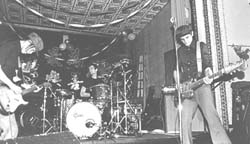|
News
|
|
|
Perspectives
|
|
|
Arts
|
|
|
Sports
|
|
|
Other
|
|

Long-Awaited Blonde Redhead Plays 'Sco Tonight
by Kurt Beals

|
|
Abstracted and Pumped: New York's Blonde Redhead are renowned for their live performances. (photo courtesy www.touchandgo.com) |
The rock which Oberlin College has been awaiting will finally arrive tonight when New York's Blonde Redhead appears with Olympia-based openers The Need in an early show at the 'Sco.
The two bands represent very different musical approaches - Blonde Redhead's music is aestheticized and abstract, while The Need launches a more direct, if tongue-in-cheek, attack - but both bands are rightfully renowned for their live performances.
Blonde Redhead, consisting of brothers Simone and Amadeo Pace, from Italy by way of Montreal, and Kazu Makino, from Japan, formed in New York in the early 1990s. Their music reflects a certain affinity for the noisy and experimental rock which already had a long history in the city by the time they arrived (the band's name is taken from a song by '80s New York band DNA). Despite frequent comparisons in their early days to Sonic Youth and other New York noisemakers, Blonde Redhead has always achieved a distinctive sound more minimalist, sparse, and structured. Rather than gritty immersion in the dirt of the city, their songs evoke almost antiseptic elevation and detachment.
This is particularly true of their more recent records. "Luv Machine," the first track on In an Expression of the Inexpressible (1998), begins with a piercing and precise attack and decays at points into a chaos in which human and electronic elements are hard to separate.
The feeling of airy detachment is even more evident on this year's Melody of Certain Damaged Lemons and the EP Mélodie Citronique (which consists primarily of translations and remixes of songs from Melody). These releases reflect a stylistic drift in the direction of 1960s French pop (an impression confirmed by the cover of the Serge Gainsbourg song "Slogan" on Mélodie Citronique), and set a tone not far from that of the films of Godard and other French New Wave directors.
Performing live, however, the band conveys not aloofness but absolute immersion in their music, particularly Makino through her practically cathartic manners of singing and moving. In appearance and movement as well as in sound, Blonde Redhead manifests a sort of precision and stylization balanced against underlying chaos.
This chaos will be represented in its full power by The Need, who open for Blonde Redhead. Foregoing the restraint that Blonde Redhead practices, the dynamic dyke duo of Rachel Carns and Radio Sloan create a cacophonous racket consisting primarily of organ, drums (played standing up) and guitar (processed through doctored pedals and amps), ranging from straight-ahead driving punk rock to the borders of electronic absurdity.
The band's vocals are sometimes playful and sarcastic but always direct, delivered in a style that has drawn comparisons to Devo and the B-52s.
Lyrically, the band takes on sex, sexuality and other subjects in ways that are serious yet challenge the very notion of seriousness at the same time.
Promotional materials for their self-titled latest album show Sloan and Carns in proto-fascist clothes and poses looking sarcastically at the camera, suggesting a mode of challenge involving both action and creative irony. This meeting of sincere but clever politics and music involving collage, chaos and occasional pop triumphs makes The Need one of the most excitingly inventive bands playing today.
Friday Nov. 17 at the 'Sco. Doors open at 9:30 p.m., show starts promptly at 10. $5 w/OCID, $7 w/o.
Copyright © 2000, The Oberlin Review.
Volume 129, Number 9, November 17, 2000
Contact us with your comments and suggestions.